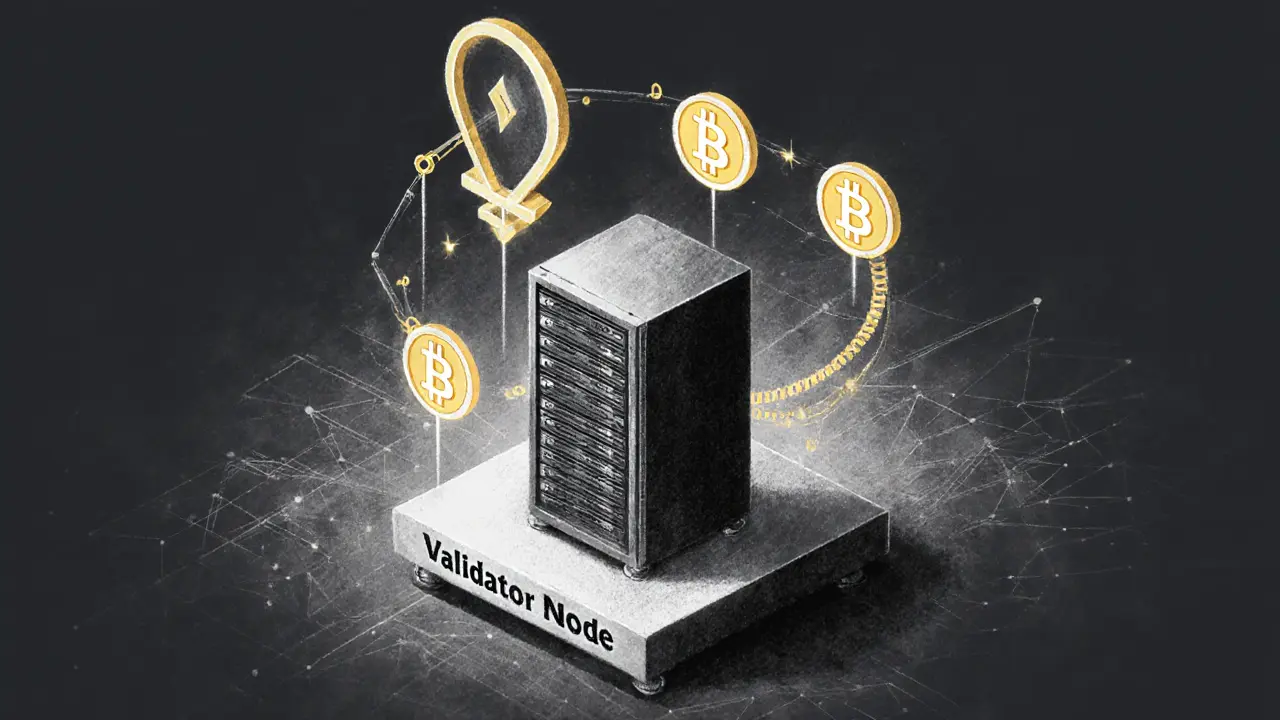Validator Rewards Calculator
Enter Your Staking Details
Estimated Validator Rewards
Ever wondered why some blockchains stay secure without the energy‑guzzling mining rigs of Bitcoin? The answer lies in validator rewards - the money‑making engine that keeps proof‑of‑stake (PoS) networks humming. In this guide we break down the economics, the key players, and the trade‑offs that shape today’s validator landscape.
What a Validator Actually Is
Validator is a node that stakes cryptocurrency to earn the right to propose and attest to new blocks in a PoS blockchain. Instead of solving cryptographic puzzles, a validator’s chance to create a block depends on how much token it has locked up and how reliably it follows the protocol. The more stake and the higher the uptime, the bigger the slice of the reward pie.
Two‑Layer Reward System
Most modern PoS chains split earnings into two distinct layers:
- Consensus layer rewards: Newly minted tokens issued by the protocol at a preset inflation rate. They compensate validators for the core duties of block attestation and proposal.
- Execution layer rewards: Transaction fees and MEV (maximal extractable value) that users pay when their transactions are included in a block. These are paid out from existing supply, not from inflation.
Ethereum, after The Merge, exemplifies this split. Consensus rewards increase a validator’s staking balance on the Beacon Chain, while execution fees flow to a validator‑specified fee‑recipient address on the execution layer.
Key Economic Parameters Across Major Networks
Each PoS network tweaks the formula to balance security, decentralization, and profitability. Below is a quick snapshot of the most influential parameters.
| Network | Consensus Inflation | Avg. Execution Fees (APY) | Typical Commission Range | Minimum Stake |
|---|---|---|---|---|
| Ethereum | ~4.5% annual | 1-3% (varies with demand) | 0-20% | 32 ETH |
| Solana | ~7% annual | 2-5% (high‑throughput fees) | 2-15% | 0.5 SOL |
| Cosmos Hub | ~5% annual | ~0.5% (low fee volume) | 5-20% | 1 ATOM |
| Avalanche | ~8.5% annual (max) | 0.8-2% (depends on subnet activity) | 0-12% | 25 AVAX |

How Rewards Flow to Delegators
Most PoS chains let token holders who lack the hardware or technical chops become delegators. They lock tokens with a validator and receive a proportional share of rewards after the validator takes a commission.
For example, on Cosmos Hub, a 1,000 ATOM block reward is split evenly among ten validators. If each validator charges a 1% commission, the validator’s pool receives 100 ATOM, of which 1 ATOM (1%) goes to the operator and the remaining 99 ATOM is divided among delegators based on their stake.
Penalty Mechanisms: Slashing and Downtime
Rewards aren’t the whole story. PoS systems enforce honest behavior with harsh penalties:
- Slashing destroys a portion of a validator’s stake if it signs contradictory blocks or goes offline for extended periods.
- Temporary exclusion from the active validator set reduces future earnings.
- Repeated offenses can lead to permanent bans.
These economic teeth keep the network secure while still making it profitable for well‑behaved operators.
Commission Strategies and Market Competition
Validators compete on three main fronts:
- Low commission rates - attracting more delegations.
- High uptime and performance - maximizing reward eligibility.
- Value‑added services - offering analytics dashboards, automatic redelegation, or insurance against slashing.
Because delegators can switch operators relatively easily, a validator that raises its commission suddenly risks a stake exodus. This market pressure keeps fees in check and encourages infrastructure upgrades.

Staking Pools and Liquid Staking
When minimum stake thresholds are too high for retail users, staking pools aggregate small deposits and delegate the combined amount to a professional validator. The pool operator deducts an operational fee (often 3-5%) before splitting the remaining rewards among participants.
Liquid staking takes it a step further: participants receive a tradable token representing their staked position (e.g., stETH on Ethereum). This token can be used in DeFi protocols while still earning the underlying staking rewards, effectively decoupling liquidity from the lock‑up period.
Institutional Involvement and Centralization Risks
As the validator economy balloons into a multi‑billion‑dollar sector, banks, exchanges, and specialized staking services are entering the arena. They bring robust infrastructure-enterprise‑grade servers, redundant network links, and 24/7 monitoring-which boosts overall network reliability.
However, concentration of stake raises centralization concerns. If a handful of entities control a significant share of total bonded tokens, they could influence governance votes or even collude to censor transactions. Communities mitigate this by setting caps on maximum delegation per validator and encouraging diverse validator ecosystems.
Future Trends: Tokenomics, New Revenue Streams, and Regulation
Looking ahead, several developments could reshape validator economics:
- Dynamic inflation models that adjust rewards based on network health metrics.
- Integration of data‑availability and cross‑chain bridge services, offering extra fee revenue to validators that run specialized nodes.
- Regulatory frameworks that define licensing requirements for staking providers, potentially adding compliance costs but also increasing user confidence.
Networks will keep experimenting to find the sweet spot where rewards stay attractive, penalties stay deterrent, and decentralization remains robust.
Frequently Asked Questions
How are validator rewards calculated on Ethereum?
Ethereum splits rewards into two parts. The consensus layer mints new ETH at roughly 4.5% annual inflation, which is distributed proportionally to each validator’s effective balance. Additionally, the execution layer pays transaction fees and MEV directly to the validator’s fee‑recipient address. Both streams are added to the validator’s balance, increasing its future reward potential.
What is the typical commission range for PoS validators?
Most validators charge between 0% and 20% of the rewards they earn on delegated stake. Low‑commission operators (0-5%) aim to attract large delegations, while high‑commission services (10-20%) often bundle additional features like slashing insurance or real‑time performance dashboards.
Can I lose my staked tokens?
Yes, through slashing. If a validator acts maliciously-double‑signs, equivocation, or prolonged downtime-a portion of its stake is permanently burned. The exact slashing percentage varies by network but can be as high as 5-15% of the misbehaving validator’s balance.
What is liquid staking and why should I care?
Liquid staking issues a tradable token that represents your staked assets (e.g., stETH for ETH). You keep earning staking rewards while the token can be used in DeFi-lending, swapping, or providing liquidity. It solves the main drawback of staking: locked capital.
Are staking pools safe?
Pools add a layer of operational risk because they rely on a third‑party operator. Reputable pools undergo audits, publish performance metrics, and often provide insurance against slashing. Still, due diligence is crucial-check the pool’s history, fee structure, and community reputation before delegating.


Look, if you’re still using proff‑of‑work mentalities, you’re stuck in the past. PoS is the future, and anyone who can’t see that is just salty.
Seriously, your attitude just shows how clueless you are about the real risks‑ like centralization‑ that these “future” systems bring.
Hey folks, great breakdown of the economics – it really helps newbies see how the reward split actually works. Keep sharing these clear guides!
While the article paints a rosy picture, one must consider the hidden layers of control that lurk beneath the surface. Governments and large institutions have been quietly investing in validator infrastructure, creating a shadow network of influence. Every time a validator is offline, the protocol penalizes it, but who watches the watchers? The public trust is built on the assumption that validators are independent, yet many are tied to corporate entities that could be coerced. Moreover, the fee models are often opaque, allowing subtle extraction of value that drifts away from ordinary delegators. This isn’t just an economic model; it’s a sociopolitical experiment where power can be concentrated without the community’s full awareness. The slashing mechanisms, while essential for security, also give the protocol a lever to discipline dissenters under the guise of honesty. In short, the incentives are designed not only to reward but also to subtly steer the network’s governance toward a few powerful actors.
Wow, the numbers sound sweet, but did you even factor in the hidden costs of running a validator farm? The hardware, electricity, and the constant “upgrade or die” pressure are massive.
That’s a fair point; the operational overhead can definitely eat into the APY.
Super exciting stuff! 🎉 Seeing how liquid staking lets you earn while staying liquid is a game‑changer for DeFi enthusiasts.
Exactly, the flexibility means more people can join without needing 32 ETH, which spreads security across more users.
When we weigh decentralization against efficiency, we’re really debating what power we want to give to the community versus a few big players.
Indeed!; the balance is delicate, but with transparent fee structures and community governance, we can keep the network healthy and inclusive.
Honestly, most people don’t realize that the “insurance” some pools claim to have is often just a marketing gimmick; you could lose everything if the operator goes rogue.
That’s why only the truly patriotic should stake with trusted national platforms.
I get the hype, but sometimes I think the market’s just over‑valuing these staking yields because of FOMO rather than actual sustainable returns.
It is indeed prudent to scrutinize the underlying assumptions of any staking model before committing capital. First, the projected APY figures typically assume ideal network conditions, which rarely persist over extended periods. Second, validator performance is contingent upon robust infrastructure, and any lapse in uptime translates directly into missed rewards. Third, the fee structures advertised by many services conceal ancillary costs, such as transaction relays and maintenance overhead. Fourth, the risk of slashing, while often described in percentages, can have outsized impact on smaller delegators. Fifth, regulatory developments may impose unforeseen compliance burdens that erode profitability. Sixth, market volatility can cause the fiat value of earned tokens to fluctuate dramatically, affecting real‑world returns. Seventh, the concentration of stake among a few large validators introduces systemic risk that is not captured in simple yield calculators. Eighth, liquidity constraints associated with lock‑up periods limit an investor’s ability to reallocate capital swiftly. Ninth, the interaction between multiple layer‑1 and layer‑2 solutions adds complexity that can unintentionally reduce effective yields. Tenth, community governance decisions, such as changes to inflation rates, can retroactively alter reward dynamics. Eleventh, the emergence of liquid staking derivatives introduces new vectors of risk, including smart‑contract vulnerabilities. Twelfth, network upgrades may temporarily disrupt validator operations, leading to temporary gaps in reward accrual. Thirteenth, the assumption of constant network demand for transaction processing is optimistic, especially in bearish cycles. Fourteenth, operational security breaches, such as key compromises, can result in irrecoverable loss of staked assets. Finally, a thorough risk‑adjusted analysis, incorporating all these factors, is essential to determine whether staking aligns with one’s investment objectives.